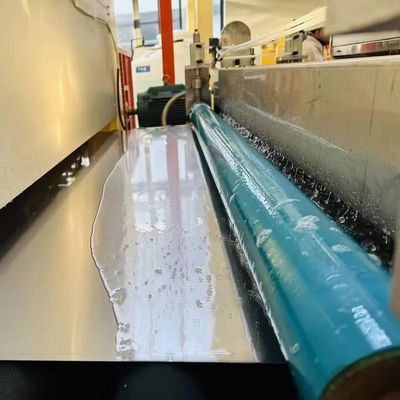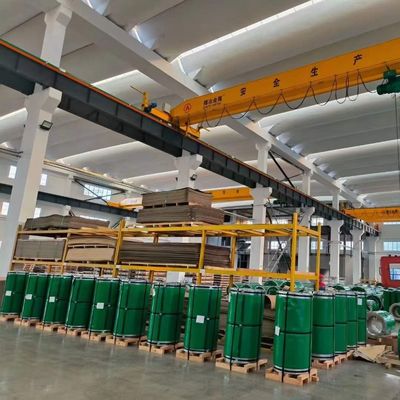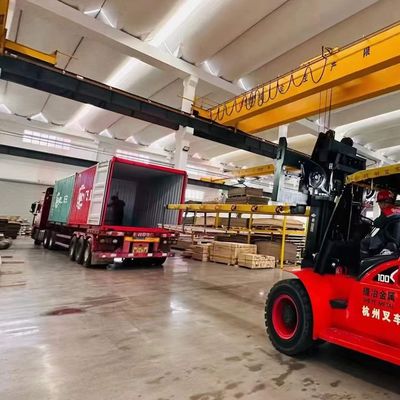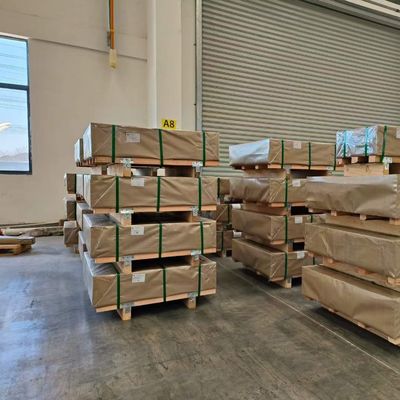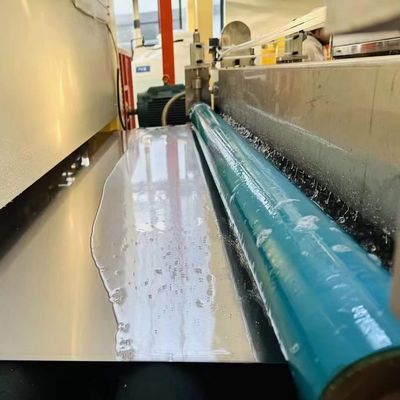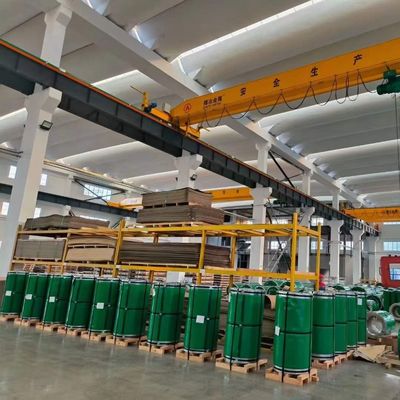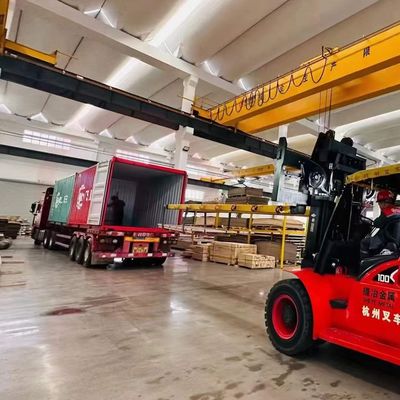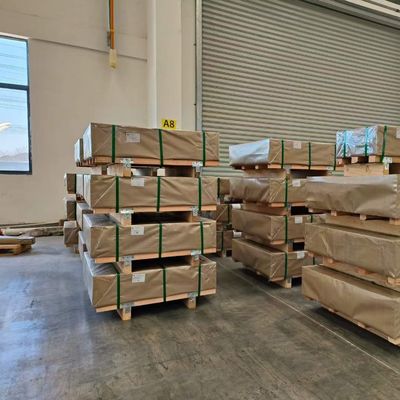-
 Raian IonescuMaterial quality very good. we have cooperate more than 10 Years. They trade lots kinds of steel material. All material quality good. They duty for all material quality. We are planing continue cooperate with them in the future
Raian IonescuMaterial quality very good. we have cooperate more than 10 Years. They trade lots kinds of steel material. All material quality good. They duty for all material quality. We are planing continue cooperate with them in the future
High Carbon 0.04% - 0.1% 316 / 316H Stainless Steel Sheet & Plate 0.4 - 3.0mm Cold Rolled
| Place of Origin | China |
|---|---|
| Brand Name | TISCO |
| Certification | ISO |
| Model Number | 316 / 316H |
| Minimum Order Quantity | 500 kgs |
| Price | 3300 - 3480 USD/Ton |
| Packaging Details | standard packing for export |
| Delivery Time | 5 - 12 days based on the quantity |
| Payment Terms | T/T, Western Union, L/C |
| Supply Ability | 10 Ton per week |

Contact me for free samples and coupons.
Whatsapp:0086 18588475571
Wechat: 0086 18588475571
Skype: sales10@aixton.com
If you have any concern, we provide 24-hour online help.
x| Products | Stainless Steel Sheet | Grade | 316 / 316H |
|---|---|---|---|
| Standard | ASTM EN JIS GB | Size | 1219*2438mm 1500*3000mm |
| Thickness | 0.5 - 3.0mm | Type | Cold Rolled |
| Service | Cutting, Surface Treatment | Application | Auto Exhaust Pipe |
| Packing | Wooden Pallets | ||
| Highlight | 0.1% Stainless Steel Sheet,316H Stainless Steel Sheet,316 Stainless Steel Sheet |
||
High Carbon 0.04% - 0.1% 316 / 316H Stainless Steel Sheet & Plate 0.4 - 3.0mm Cold Rolled
Products Specification
|
Product Name
|
316H Stainless Steel Sheets
|
|
Material Type
|
Ferrite stainless steel, magnetic; Austenitic stainless steel, Non-magnetic.
|
|
Grade
|
300series:301,302,303,304,304L,309,309s,310,310S,316,316L,316Ti,317L,321,347
|
|
200series:201,202,202cu,204
|
|
|
400series:409,409L,410,420,430,431,439,440,441,444
|
|
|
Others:2205,2507,2906,330,660,630,631,17-4ph,17-7ph, S318039 904L,etc
|
|
|
Duplex stainless steel:S22053,S25073,S22253,S31803,S32205,S32304
|
|
|
Special Stainless Steel:904L,347/347H,317/317L,316Ti,254Mo
|
|
|
Technology
|
Cold Rolled /Hot Rolled
|
|
Length
|
2000/2438/2500/3000/3048 mm
|
|
Width
|
1000/1219/1250/1500 mm
|
|
Thickness
|
0.4-3mm(cold Rolled), 3-200mm(hot Rolled)
|
|
|
BA, 2B, NO.1,2D, 4K, 6K, 8K, NO.4, HL, SB, Embossed,perforated etc.
|
|
Leveling: improve flatness, esp. for items with high flatness request.
|
|
|
Skin-Pass: improve flatness, higher brightness
|
|
|
Other Choices
|
Cutting:Laser cutting, help the customer to cut the required size
|
|
Protection
|
1. Inter paper available
|
|
2. PVC protecting film available
|
|
|
Price Item
|
FOB,CIF,DDU,FCA,EXW ,.etc
|
|
Quality Assurance
|
1.Provide MTC (Mill Test).
2.Accept the inspection by the third party agent
|
316 Stainless Steel is the standard molybdenum-bearing austenitic grade and a typical 18-10 stainless steel grade, the molybdenum in 316 provides better overall corrosion-resistant properties than grade 304, particularly higher resistance to pitting and crevice corrosion in chloride environments. The austenitic structure gives excellent toughness, even down to cryogenic temperatures.
The main difference between series 304 and grade 316 is the presence of molybdenum in series 316 at percentages of 2% to 3%, which identifies series 316 as a Cr-Ni-Mo system. Adding molybdenum makes grade 316 resistant to pitting caused by phosphoric acid, acetic acid, and dilute chloride solutions. The strength and toughness of molybdenum increase series 316’s heat and wear resistance.
316 Stainless Steel Characteristics
- Cold rolled products have a good glossy appearance;
- Non-Magnetic
- Excellent corrosion resistance, especially pitting resistance, due to the addition of Mo (2~3%)
- Excellent strength at high temperature
- Excellent work-hardening properties (weak magnetism after processing)
- Solid solution state non-magnetic
- Good welding performance. Can be welded by all standard welding methods. Welding can be performed with 316Cb, 316L or 309Cb stainless steel filler rod or electrode, respectively, depending on the application. For optimum corrosion resistance, welded sections of 316 stainless steel need to be annealed after welding. If 316L stainless steel is used, no post-weld annealing is required.
316 Stainless Steel Chemical Composition
The chemical composition of 316 stainless steel contains 16 to 18% chromium, 10 to 14% nickel content, and 2.00-3.00 molybdenum with max 0.08% carbon content, adding molybdenum to stainless steel 316 increases its corrosion resistance compared to other grades of stainless steel. The addition of other alloys further enhances its properties.
| Standard | Grade | C | Mn | P | S | Cr | Ni | Mo | N | Iron |
|---|---|---|---|---|---|---|---|---|---|---|
| ASME II A SA-240 | 316 | ≤0.080 | ≤2.00 | ≤0.045 | ≤0.030 | 16.0-18.0 | 10.0-14.0 | 2.00-3.00 | ≤0.10 | Bal. |
| ASTM A240 | 316 | ≤0.080 | ≤2.00 | ≤0.045 | ≤0.030 | 16.0-18.0 | 10.0-14.0 | 2.00-3.00 | ≤0.10 | Bal. |
| EN 10088-2 | 1.4401 | ≤0.070 | ≤2.0 | ≤0.045 | ≤0.030 | 16.5-18.5 | 10.0-13.0 | 2.0-2.5 | ≤0.10 | Bal. |
316 Stainless Steel Mechanical Properties
Stainless steel 316 is the second most widely used stainless steel grade. 316 is preferred due to the presence of molybdenum, which makes it suitable for applications with a higher risk of a chemical attack, especially from chloride solutions. Aside from the alloying of molybdenum, most of its desirable properties are attributed to its austenitic microstructure.
| Standard | Grade | Yield Point | Tensile Strength | Elongation | Hardness | Hardness |
|---|---|---|---|---|---|---|
| MPa | MPa | % | HRB | HB | ||
| ASME II A SA-240 | 316 | ≥ 205 | ≥ 515 | ≥ 40 | ≤ 95 | ≤ 217 |
| ASTM A240 | 316 | ≥ 205 | ≥ 515 | ≥ 40 | ≤ 95 | ≤ 217 |
| EN 10088-2 | 1.4401 | ≥ 240 | 530-680 | ≥ 40 |
316 Stainless Steel Physical Properties
| Physical Properties | |
|---|---|
| Material Density | 8000 Kg/M3 |
| Elastic Modulus | 193 GPascal |
| Mean Thermal Expansion Coefficient | 16.5 Μm/M/OC |
| Mean Thermal Conductivity | 18.9 W/M*K |
| Specific Heat Capacity | 500 J/Kg*K |
| Electrical Resistivity | 740 (NΩ*M) |
| Melting Onset | 1380 OC / 2510 OF |
| Melting Completion | 1400 OC / 2550 OF |
| Embodied Energy | 53 MJ/Kg |
| Calomel Potential | -50 MV |
316, 316L, 316H, 316TI, 316N, 316LN Comparison
Stainless steel 316L, the low-carbon version of 316, is highly resistant to sensitization (grain boundary carbide precipitation) and so is extensively used in heavy gauge welded components (about 5mm and over). Grade 316H, with its higher carbon content, has some application at elevated temperatures, as does stabilised grade 316Ti. Nitrogen-strengthened versions also exist as 316N and 316LN.
| Grade | Alloying Elements (Percent) | |||||||||
|---|---|---|---|---|---|---|---|---|---|---|
| C | Cr | Ni | Mo | Mn | Si | N | P | S | Others | |
| 316 | 0.08 | 16-18 | 10-14 | 2-3 | 2.0 | 0.75 | 0.10 | 0.045 | 0.03 | |
| 316L | 0.03 | 16-18 | 10-14 | 2-3 | 2.0 | 0.75 | 0.10 | 0.045 | 0.03 | |
| 316H | 0.04 – 0.10 | 16-18 | 10-14 | 2-3 | 2.0 | 0.75 | 0.045 | 0.03 | ||
| 316Ti | 0.08 | 16-18 | 10-14 | 2-3 | 2.0 | 0.75 | 0.10 | 0.045 | 0.03 | Ti¹ |
| 316Cb | 0.08 | 16-18 | 10-14 | 2-3 | 2.0 | 0.75 | 0.10 | 0.045 | 0.03 | Cb² |
| 316N | 0.03 | 16-18 | 10-14 | 2-3 | 2.0 | 0.75 | 0.10 – 0.16 | 0.045 | 0.03 | |
| 316LN | 0.03 | 16-18 | 10-14 | 2-3 | 2.0 | 0.75 | 0.10 – 0.16 | 0.045 | 0.03 | |
Equivalents Of Grade 316
| EU EN |
USA | Germany DIN,WNr |
Japan JIS |
France AFNOR |
England BS |
Italy UNI |
China GB |
Sweden SS |
Czechia CSN |
Austria ONORM |
Russia GOST |
|---|---|---|---|---|---|---|---|---|---|---|---|
| X5CrNiMo17-12-2 (1.4401) | 316 | X5CrNiMo17-12-2 | SUS316 | Z6CND17-11 Z7CND17-11-02 Z7CND17-12-02 | 316S31 | X5CrNiMo17-12 | 0Cr17Ni12Mo2 | 2347 | 17346 | X5CrNiMo17-12-2KW | 08KH16N11M3 |
Corrosion Resistance
Stainless steel 316 has excellent corrosion resistance in a range of atmospheric environments and many corrosive media, generally, it is better than 304 grade. 316 is usually regarded as the standard “marine grade” stainless steel, but it is not fully resistant to sea water. In many marine environments, 316 does exhibit surface corrosion. There is usually no difference in corrosion resistance between 316 and 316L.
Heat Resistance
316 stainless steel has good oxidation resistance at intermittent service temperatures up to 870°C and continuous service temperatures up to 925°C. Grade 316 is not recommended for continuous use in the 425-860°C temperature range. Continuous use of 316 is not recommended in the temperature range 425-860°C. Grade 316L is more resistant to carbide precipitation and can be used in the above temperature range. 316H grades have higher strength at elevated temperatures and can sometimes be used in structural and pressure-containing applications at temperatures higher than about 500°C, but titanium-stabilized grades 316Ti are often a more suitable choice.
Heat Treatment Solution Treatment (Annealing)
Stainless steel 316 cannot be hardened by heat treatment.
Solution treatment or annealing can be done by rapid cooling after heating to 1010-1120°C.
Welding
Excellent weldability by all standard fusion methods, both with and without filler metals. AS 1554.6 pre-qualifies welding of 316 with Grade 316 and 316L with Grade 316L rods or electrodes (or their high silicon equivalents). Heavy welded sections in Grade 316 require post-weld annealing for maximum corrosion resistance. This is not required for 316L. Grade 316Ti may also be used as an alternative to 316 for heavy-section welding.
Machining
Stainless steel 316 has good machinability. Machining can be enhanced using the following rules:
- Cutting edges must be kept sharp. Dull edges cause excess work hardening.
- Cuts should be light but deep enough to prevent work hardening by riding on the surface of the material.
- Chip breakers should be employed to assist in ensuring the swarf remains clear of the work
- Low thermal conductivity of austenitic alloys results in heat concentrating at the cutting edges. This means coolants and lubricants are necessary and must be used in large quantities.
316 Stainless Steel Forms
- Sheet
- Strip
- Bar
- Plate
- Pipe
- Tube
- Coil
- Fittings
316 Stainless Steel Application
316 grade exhibits improved heat tolerance, resistance to creep and pitting, and excellent tensile strength. Known for its ability to withstand the effects of exposure to chlorides, the alloy is used extensively in chemical and marine applications, as well as many other industries.
316 stainless steel exhibits better corrosion and pitting resistance to chlorides than 304 stainless steel and higher levels of strength at elevated temperatures. This is due in part to the addition of molybdenum. This is what makes it an ideal grade for such applications as pumps, valves, textile and chemical equipment, pulp & paper and marine applications. 316L stainless steel is the extra low-carbon version of 316 stainless steel that helps avoid carbide precipitation due to welding.
- Medical and Pharmaceutical Industry: 316 is commonly used for manufacturing surgical instruments due to its biocompatibility and corrosive resistance.
- Aerospace Industry: type 316 is used in aircraft and aerospace applications. These include parts for engines, structural components, and fasteners.
- Automotive Industry: In automotive manufacturing, 316 parts are used for various components, including exhaust systems, engine parts, and decorative trim.
- Marine Industry: Due to its superior resistance to saltwater and marine environments, 316 is extensively used for marine equipment. Examples include boat fittings, propellers, and other components.
- Food Processing and Beverage Industry: 316 stainless steel is crucial in food and beverage processing equipment. Stainless steel is inherently non-reactive and posses hygienic properties.
- Chemical and Petrochemical Industry: The resistance of 316 to various chemicals and corrosive substances makes it suitable for manufacturing valves, pumps, tanks, and other equipment used in chemical processing.
- Oil and Gas Industry: 316 components are employed in offshore drilling rigs and pipelines. Stainless Steel is popular because of its ability to withstand harsh environments.
- General Manufacturing: Various industries, including industrial equipment, machinery, and tooling, 316 stainless steel products for their robustness and reliability.
316 Stainless Steel Food Grade
316 grade stainless steel is commonly used as a food-grade material primarily because it is highly resistant to corrosion. It is also non-reactive with acidic or alkaline substances commonly found in food and beverages. This makes it the perfect material for food processing and storage equipment, such as tanks, piping, and utensils.
Additionally, 316 stainless steel contains molybdenum, which enhances its corrosion resistance and makes it particularly effective in harsh environments where it may be exposed to chemicals or saltwater. This means that it is the go-to grade for applications in marine locations. The composition of 316 stainless steel also makes it easy to clean and sanitize, which is important in food processing facilities to prevent the growth of harmful bacteria.
316 Stainless Steel Magnetic Property
316 grade stainless steel is non-magnetic theoretically because it contains high amounts of austenite, a phase of iron that is nonmagnetic, however, it may be transformed from non-magnetic to magnetic phases, type 316 displays slight magnetism when it is cold-worked when it is heat solution condition, it is non-magnetic.
316 Stainless Steel Finishes
316 Stainless Steel finishes involve a comprehensive understanding of both the material properties and the surface treatment processes.
Passivation:
The chemical process of passivation enhances the corrosion resistance of stainless steel by forming a passive oxide layer on its surface. This layer acts as a barrier against corrosion, making the stainless steel more resistant to rusting, staining, and pitting.
Polishing
316 Stainless Steel Polishing refers to the use of mechanical, chemical, or electrochemical effects, to reduce the surface roughness of the workpiece, to obtain a bright, flat surface processing method. The main use of polishing tools and abrasive particles, etc. on the surface of the workpiece to carry out the finishing process.
| Standard | Grade | Yield Point | Tensile Strength | Elongation | Hardness | Hardness |
|---|---|---|---|---|---|---|
| MPa | MPa | % | HRB | HB | ||
| ASME II A SA-240 | 316 | ≥ 205 | ≥ 515 | ≥ 40 | ≤ 95 | ≤ 217 |
| ASTM A240 | 316 | ≥ 205 | ≥ 515 | ≥ 40 | ≤ 95 | ≤ 217 |
| EN 10088-2 | 1.4401 | ≥ 240 | 530-680 | ≥ 40 |
![]()
![]()
![]()
![]()



